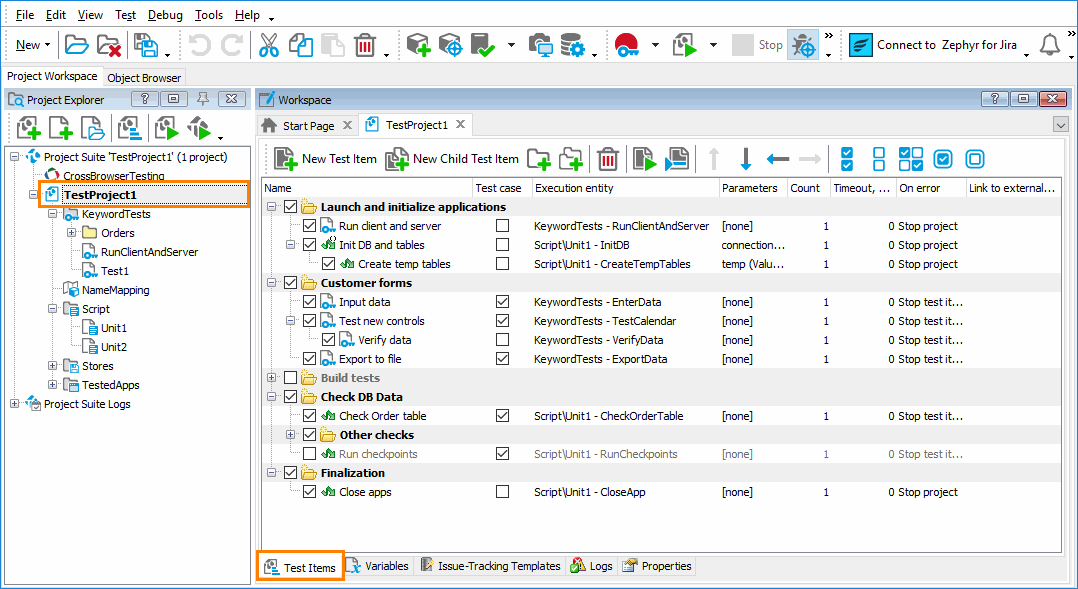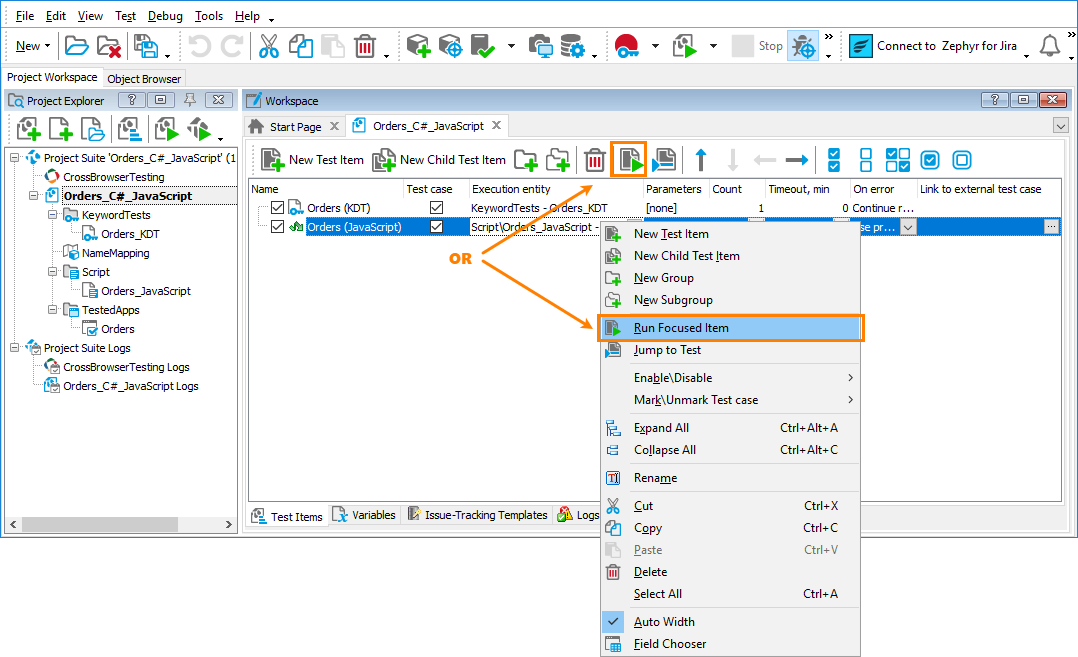On the Test Items page of your project, you can view and change the test run order of your project. To open the Test Items page, do any of the following:
-
Select View > Organize Tests from the TestComplete main menu.
-
Double-click the project node in the Project Explorer and open the project editor and then switch to the Test Items page.
-
Select your project in the Project Explorer and click
 Organize Tests on the panel’s toolbar.
Organize Tests on the panel’s toolbar. -
Right-click your project in the Project Explorer and select Edit > Test Items from the context menu.
Test Item Properties
The Test Items page shows the project’s test items in the order they will be run. Any project item that can be run can be a test item: a keyword test, a script routine, a low-level procedure, a unit test, and so on.
You can organize test items into a plain list, grouped list or a tree-like structure (where child items are run after the parent item has finished running). You can exclude test items from or include them in the test run using the check box next to the test item name.
The following table contains descriptions of test item properties.
 Test item properties are not applied to tests that are not launched as test items (for example, they are launched from the Project Explorer or are called from another test).
Test item properties are not applied to tests that are not launched as test items (for example, they are launched from the Project Explorer or are called from another test).
| Column | Description | ||
|---|---|---|---|
| Name | The test item name. | ||
| Test case | Marks the test item as a test case. This item will be included in the Summary report. Notes:
|
||
| Execution entity | The project item to be run. It can be: a keyword test, script routine, BDD scenario or feature file, low-level procedure, network suite and so on. To choose a test, click the ellipsis button and use the resulting Select Test dialog. | ||
| Count | The number of times the test will be repeated. Default is 1. | ||
| Timeout | The maximum run time (in minutes) for the test item. If the run time exceeds the timeout, TestComplete posts an error to the test log and generates the OnTimeout event. You can create a handler for this event to stop the current test item and proceed to the next one. See Stopping Tests on Timeout.
Default is 0, which means no timeout. |
||
| Parameters | Parameter values for the test (only for keyword tests and script routines). To specify parameter values, press the ellipsis button and use the resulting Test Parameters dialog. You can specify either hard-coded parameter values, or project variables. | ||
| On error |
Specifies what TestComplete will do if an error occurs during the test item run:
For more information on using the On error property, see About Controlling Test Execution Flow. Note: This property does not apply to errors that occur on remote computers during distributed testing. |
||
| On exception | Specifies what TestComplete will do if an unhandled script exception occurs during the test item run. Some examples of these exceptions are: an invalid function name, an invalid parameter value, and so on.
For more information on using this option, see About Controlling Test Execution Flow.
|
||
| Link to external test case | Specifies the external test to which your test item is bound if your TestComplete project is bound to an external test management system (for instance, Zephyr for Jira). You can click the ellipsis button and select the needed Zephyr test case in the resulting wizard. If your TestComplete project is not bound to a Jira project yet, configure the connection in the resulting wizard, and then select the needed test case. You can also type the identifier of an external test manually. To bind your test item to a Zephyr test case, use the following format:
To learn more about automating Zephyr tests with TestComplete, see Integration With Zephyr for Jira. Notes:
|
||
| Description | An arbitrary description of the test item. |
If a column is hidden, to make it visible, right-click anywhere on the page, click Field Chooser, and then drag the needed column from the resulting list to the page.
You can customize the column layout. For example, you can reorder or hide some columns. For more information, see Arranging Columns, Lines and Panels.
Working With the Page
 To modify test item properties
To modify test item properties
 To copy an existing test item or group
To copy an existing test item or group
 To include or exclude test items from a test run
To include or exclude test items from a test run
 To mark a test item as a test case
To mark a test item as a test case
 To link a test item to a test case in an external test management system
To link a test item to a test case in an external test management system
 To change the run order of test items
To change the run order of test items
 To navigate to the test source
To navigate to the test source
 To expand or collapse test items
To expand or collapse test items
 To delete a test item or group
To delete a test item or group
Running Test Items
This section describes how you can run test items other than manually from the Test Items page (see above).
-
From the command line.
By default, when you run a project from the command line, the project executes all enabled test items specified on its Test Items page. In addition, you can use the /test (/t) command-line argument to explicitly specify test items you want to run.
Note: TestComplete will run only the enabled test items, it will not run the disabled items. For example, the following command runs TestComplete, loads the specified project suite (MySuite.pjs), and commands TestComplete to run the ProjectTestItem1 test item of the MyProj project:
TestComplete.exe "C:\My Projects\MySuite.pjs" /r /p:MyProj /t:ProjectTestItem1
-
As part of a CrossBrowserTesting run.
Add the needed test items to the CrossBrowserTesting manager, specify the environments where you want to run the test items, and run them either manually from the manager or automatically from the command line. To learn more about running tests in CrossBrowserTesting environments, see Running Tests in CrossBrowserTesting Environments.
-
As part of an automated build and test process managed by Jenkins.
You can add the TestComplete Test build step to your build process in Jenkins and configure it to run the needed test item. See Integration With Jenkins.
-
From Visual Studio.
If you have TestComplete 14 Integration Package installed in your Visual Studio, you can add TestComplete 14 Test items to your Visual Studio test projects, specify a TestComplete project’s test items which these items should run, and run them either directly from Visual Studio, or as part of a build or release pipeline. To learn more, see Integration With Azure DevOps and Team Foundation Server.
-
From an external application via COM.
Use the
Integration.RunProjectTestItemmethod to run a test item of a project. To learn more about running tests via COM, see Working With TestComplete via COM.
TestComplete 32-bit executable is located in the <TestComplete>\Bin folder.
TestComplete 64-bit executable is located in the <TestComplete>\x64\Bin folder.
See Also
Projects in TestComplete
Tests, Test Items, and Test Cases
Running, Pausing and Stopping Automated Tests
Stopping Tests on Timeout


 Test Item Properties
Test Item Properties



















